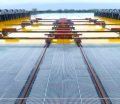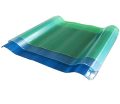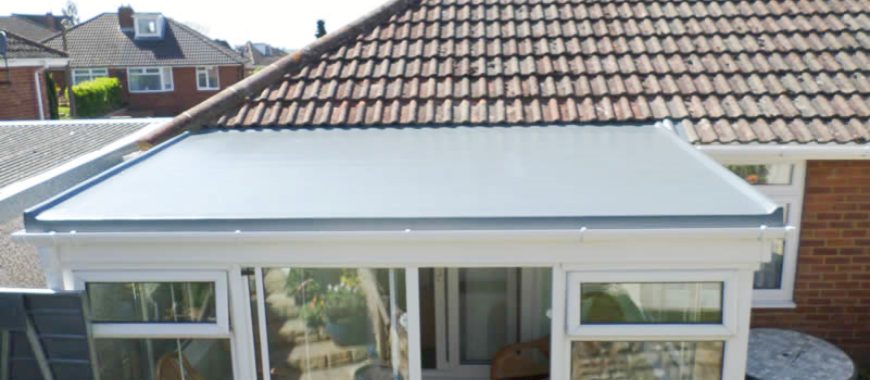
GRP conservatory roofs are gaining widespread popularity for their durability and energy-saving qualities. Homeowners are choosing this option over traditional materials due to its superior performance. GRP Conservatory Roof reducing heat build up in the summer, keeping it warm in the winter With durability and watertight finish. Selecting the right roofing material is essential to enhance energy efficiency and improve year-round comfort in conservatories. A grp conservatory roof offers better insulation, helping to regulate temperature more effectively compared to glass or polycarbonate roofs. This can significantly reduce energy bills over time. Though the initial cost might be higher, the long-term benefits of a GRP roof replacement, such as lower maintenance needs and extended lifespan, make it a valuable investment for homeowners looking for a durable and cost-efficient solution. Additionally, fiberglass sheets are a key component used in the construction of GRP conservatory roofs, providing strength, durability, and excellent weather resistance for the roof structure. When coupled with the best fiberglass sheets, these roofs ensure enhanced strength and resilience, providing an optimal balance of insulation, durability, and weather resistance.
What is a GRP Conservatory Roof?
A GRP conservatory roof is made from Glass Reinforced Plastic (GRP), also call FRP, a highly durable and versatile material. GRP is a lightweight yet robust option, designed to provide excellent weather resistance, insulation, and structural strength. It is widely used in various industries, including marine and construction, due to its water-resistant properties. For conservatories, a grp conservatory roof ensures long-term protection against the elements while offering superior insulation. Additionally, incorporating a GRP rooflight into the design can enhance natural light intake, creating a bright and inviting space while maintaining the roof’s durability and weather resistance.
Comparison Between GRP, Felt, and Rubber Roofs
When comparing a grp conservatory roof to felt or rubber roofing options, GRP stands out for its long-lasting durability. Felt roofs may be cheaper initially but tend to wear down faster, often requiring regular maintenance or replacement. Rubber roofs offer better flexibility, but they don’t match the waterproof and seamless finish of a GRP roof. GRP roofs are fully watertight with no joints, making them far more reliable in preventing leaks over time.
| Feature | GRP Roof | Felt Roof | Rubber Roof (EPDM) |
|---|---|---|---|
| Material Composition | Fiberglass reinforced plastic | Bitumen-based felt material | Ethylene Propylene Diene Monomer (EPDM) |
| Durability | Extremely durable, lasts 20–30+ years | Moderate, lasts 10–15 years | High, lasts 20–50 years |
| Weather Resistance | Excellent, resistant to extreme weather | Moderate, may degrade under heavy rain/sun | Excellent, UV and weather-resistant |
| Flexibility | Rigid, best for flat or low-slope roofs | Flexible but prone to cracks over time | Highly flexible, adapts to roof movement |
| Ease of Installation | Requires professional installation | Easier to install, suitable for DIYers | Relatively easy but best done by professionals |
| Aesthetic Appeal | Sleek and modern finish, available in various colors | Basic look, limited color options | Clean, minimalistic, mostly black |
| Cost | High initial cost | Low to moderate cost | Moderate initial cost |
| Maintenance | Low maintenance | Requires regular checks and repairs | Minimal maintenance required |
| Weight | Lightweight | Lightweight | Lightweight |
| Environmental Impact | Recyclable but production is energy-intensive | Low, but may contain non-biodegradable components | Eco-friendly, fully recyclable |
| Suitability | Ideal for modern homes and small flat roofs | Suitable for sheds and smaller structures | Versatile, great for residential and commercial roofs |
- GRP Roofs: Best for modern aesthetics and durability, suitable for high-end applications but with higher upfront costs.
- Felt Roofs: Affordable and simple, ideal for temporary or low-budget projects.
- Rubber Roofs: A middle ground with long lifespan, flexibility, and eco-friendliness, making it a popular choice for most residential needs.
Proven Reliability of GRP Roofs in the UK
GRP has been a trusted roofing solution in the UK for over 50 years. Its durability, combined with its ability to withstand harsh weather conditions, makes it a preferred choice for conservatories. With a grp conservatory roof, homeowners can expect not only enhanced energy efficiency but also minimal maintenance, ensuring it remains a reliable option for decades.
Insights into FRP Pipe Schedule Chart for Industry Professionals
The Cost of GRP Conservatory Roofs
Glass Reinforced Plastic (GRP), often referred to as fiberglass, has become an increasingly popular choice for conservatory roofs. Known for its durability, lightweight properties, and sleek appearance, GRP offers a modern and efficient solution for homeowners. However, the cost of GRP conservatory roofs can vary based on several factors. Here, we’ll explore these aspects in detail.
Base Cost of GRP Conservatory Roofs
The starting price for a GRP conservatory roof typically ranges between £2,500 and £6,000, depending on the size and design complexity of the conservatory. This base cost generally includes:
- Material costs: GRP materials are high-quality and weather-resistant, contributing significantly to the overall price.
- Labor charges: Professional installation ensures a watertight and secure finish, adding to the cost.
- Standard features: Basic features such as insulation layers and UV protection are often included.
Factors Affecting the Cost
Several variables can influence the total expense of a GRP conservatory roof:
Size and Shape
- Larger roofs require more material and labor, increasing the price.
- Complex shapes, such as Victorian or P-shaped conservatories, demand more customization, which adds to the cost.
Insulation and Thermal Efficiency
- Advanced insulation options, including multi-layered thermal barriers, can raise the cost by £500 to £1,500.
- These features are crucial for maintaining a comfortable temperature year-round and reducing energy bills.
Additional Features
- Skylights or roof vents: Adding features like skylights can cost an extra £300 to £1,000 per unit, depending on the size and type.
- Custom finishes: Textured or colored GRP coatings can increase the price by approximately 10-20%.
Installation Complexity
- Homes with difficult access or existing structural issues may require additional work, costing anywhere from £500 to £2,000 more.
The cost of a GRP conservatory roof is influenced by its size, design, features, and installation requirements. While the initial expense might seem high, the material’s durability, energy efficiency, and low maintenance make it a worthwhile investment. For homeowners seeking a sleek, modern, and reliable solution, GRP conservatory roofs offer exceptional value over the long term.
Grp Conservatory Roof Price
The grp conservatory roof price varies based on several factors. On average, the cost of installing a GRP conservatory roof ranges from $3,000 to $6,500, depending on the size and complexity of the project. Larger conservatories or those with intricate designs will increase installation costs due to the additional materials and labor required.
Key factors influencing the price include the size of the roof, the design, and any additional features like skylights or non-slip finishes. The complexity of the installation process also affects the overall cost. For example, roofs with unusual shapes or multiple angles may require more detailed work, thus increasing the labor fees.
When comparing a grp conservatory roof with other materials like felt or tile, GRP generally has a higher initial cost. However, its long-term durability and low maintenance requirements often make it more cost-effective. Felt roofs, while cheaper, typically need replacement sooner, leading to additional costs over time. Tile roofs can be visually appealing but are heavier, and may require structural reinforcements that increase both labor and material costs.
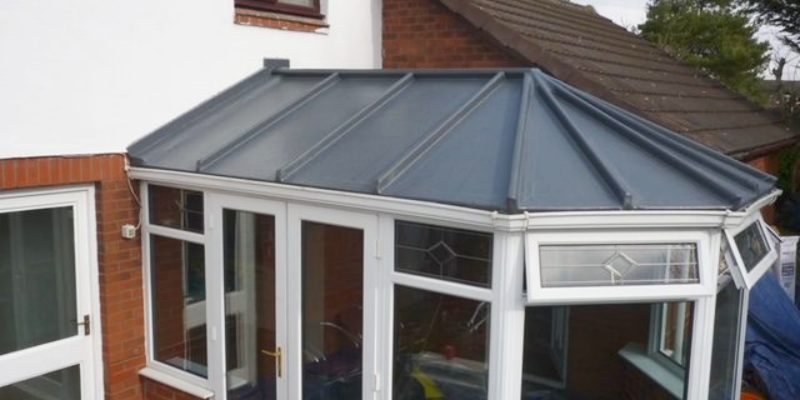
Benefits of GRP Conservatory Roofs
Durability and Low Maintenance
One of the most significant benefits of a grp conservatory roof is its exceptional durability. GRP (Glass Reinforced Plastic) roofs are designed to last for decades, with many manufacturers offering warranties of up to 30 years. This longevity makes it a solid investment for homeowners seeking a long-term solution for their conservatories. Unlike traditional roofing materials, such as felt or polycarbonate, GRP roofs are built to withstand wear and tear without the need for frequent repairs or replacements.
A key factor in the durability of a grp conservatory roof is the absence of seams or joints. Seamless roofs are less prone to cracks and splits, which can lead to leaks or structural damage over time. The monolithic design of GRP roofs ensures that they remain strong and intact even in harsh weather conditions. This seamless structure also means there is less need for regular maintenance. While most roofing systems require frequent inspections and repairs to prevent water ingress or damage, GRP roofs require minimal upkeep. Homeowners can enjoy peace of mind knowing their conservatory is protected by a roofing system that is both resilient and low-maintenance.
Watertight and Weatherproof
Another standout feature of a grp conservatory roof is its watertight and weatherproof properties. The seamless application of GRP ensures that the roof is completely impermeable to water, which is essential for protecting the interior of a conservatory from leaks and moisture damage. In regions where heavy rainfall or harsh weather is common, this benefit becomes even more valuable. GRP roofs can effectively prevent water from seeping into the structure, safeguarding not only the conservatory but also its contents.
GRP’s weatherproof nature also extends to its ability to withstand extreme temperatures, UV rays, and other environmental factors. The material is highly resistant to cracking, warping, or fading, even when exposed to intense sunlight or fluctuating temperatures. Traditional roofing materials like felt or polycarbonate may struggle to cope with such conditions, leading to degradation over time. In contrast, a grp conservatory roof maintains its structural integrity and appearance for years, offering superior protection against the elements.
Energy Efficiency
Energy efficiency is a crucial consideration for homeowners looking to optimize their conservatories for year-round use. A GRP conservatory roof excels in this area by providing excellent insulation. The material’s glass property plays a key role in its thermal performance, helping to regulate the temperature inside the conservatory, keeping it cool in summer and warm in winter. This is a significant improvement over traditional roofing materials like polycarbonate or glass, which often allow heat to escape or accumulate, making the conservatory uncomfortable during extreme weather.
By improving insulation, GRP conservatory roofs help reduce energy consumption. Homeowners can rely less on heating and cooling systems, which translates to lower energy bills and a reduced carbon footprint. The enhanced energy efficiency of a GRP roof makes it an environmentally friendly choice, benefiting both the homeowner and the planet.
Aesthetic Flexibility
A grp conservatory roof offers significant aesthetic flexibility, allowing homeowners to customize the look of their conservatories. GRP roofs can be tailored to fit any architectural style, whether contemporary or traditional. They are available in a variety of colors and finishes, including options that mimic the appearance of tiles or slate. This means that homeowners can choose a roofing solution that complements the design of their home, creating a cohesive and attractive exterior.
Moreover, GRP roofs can be designed to accommodate additional features, such as skylights or roof windows, which enhance natural lighting and ventilation in the conservatory. The flexibility of GRP also allows for the inclusion of non-slip finishes, making it ideal for walkable roof areas or balconies. This adaptability ensures that homeowners can enjoy both the functional and aesthetic benefits of their GRP conservatory roof, tailored to their specific needs and preferences.
Environmental Friendliness
In addition to its energy efficiency, a grp conservatory roof is an environmentally friendly option due to its long lifespan and minimal maintenance requirements. The production of GRP involves fewer resources than traditional roofing materials, and its extended durability means less waste over time. Unlike felt or rubber roofs that may need replacing every few years, a GRP roof can last several decades, reducing the need for frequent replacements and the associated environmental impact.
GRP is also fully recyclable at the end of its life cycle, making it a sustainable roofing solution. By choosing a grp conservatory roof, homeowners not only benefit from reduced energy usage and costs but also contribute to the overall reduction of environmental waste. This makes GRP an ideal choice for eco-conscious homeowners looking to invest in sustainable home improvements.
Essential Specifications for FRP Cable Threading Pipe Use
Why Choose GRP Conservatory Roof over Felt or Rubber?
When selecting a roofing material for your conservatory, the choice of material can significantly impact the durability, aesthetic appeal, and overall performance of the roof. Glass Reinforced Plastic (GRP) stands out as a superior option compared to felt or rubber roofing. Below, we outline the key reasons why GRP is a better choice.
Superior Durability
- GRP: Known for its exceptional durability, GRP roofs can last for 25 years or more with minimal maintenance. The material is resistant to cracking, splitting, or weathering, even in extreme climates.
- Felt: Typically lasts 10-15 years and is prone to tearing and degradation over time, especially under harsh weather conditions.
- Rubber: While EPDM rubber roofing has better longevity than felt, it is still more susceptible to punctures and wear compared to GRP.
Aesthetic Appeal
- GRP: Offers a smooth, seamless finish that enhances the modern look of a conservatory. The material is available in various colors and textures, allowing for customization to match your home’s style.
- Felt: Often considered less attractive, felt roofs have a utilitarian appearance that may not complement a stylish conservatory.
- Rubber: Although slightly more appealing than felt, rubber roofs still lack the polished look of GRP, which provides a more refined finish.
Weather Resistance
- GRP: Highly resistant to all weather conditions, including heavy rain, snow, and UV radiation. Its seamless surface prevents water ingress, eliminating the risk of leaks.
- Felt: Susceptible to leaks and pooling water, particularly as it ages. Felt can crack under temperature fluctuations, leading to water damage.
- Rubber: Performs well in resisting water but can shrink or crack over time, particularly if poorly installed.
Seamless and Leak-Proof Design
- GRP: Installed as a single, seamless layer, GRP roofs are completely waterproof and eliminate weak points that could cause leaks. This is particularly beneficial for conservatories, where water ingress can damage interiors.
- Felt: Installed in overlapping layers, creating seams that are prone to leaking over time.
- Rubber: Typically installed with seams that, if not sealed correctly, can lead to leaks.
Maintenance and Longevity
- GRP: Requires minimal maintenance. Its robust surface resists algae, mold, and moss, keeping it looking clean and new for decades.
- Felt: Needs regular maintenance and repairs to address cracks, leaks, and wear.
- Rubber: Requires occasional maintenance to address issues like punctures or loose edges.
GRP conservatory roofs offer unparalleled advantages over felt and rubber roofing materials. They excel in durability, weather resistance, aesthetic appeal, and maintenance. While the initial cost may be higher, the long-term savings and superior performance make GRP the smarter investment. For homeowners seeking a reliable, sleek, and low-maintenance roofing solution, GRP is the clear choice.
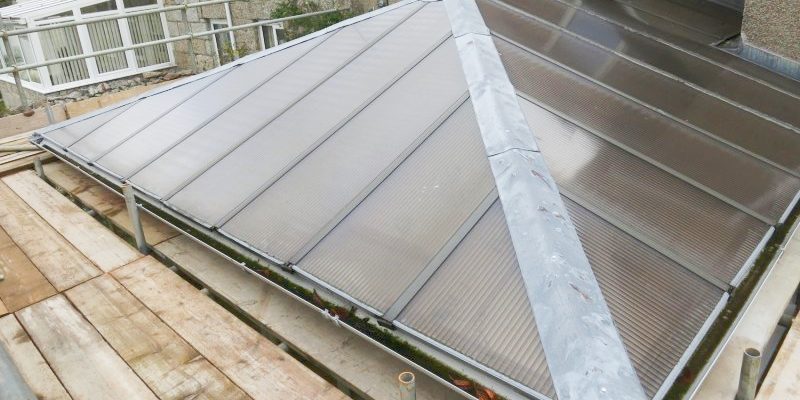
GRP Conservatory Roof Replacement
When to Consider a Replacement
A grp conservatory roof replacement should be considered when signs of wear, damage, or inefficiency start to appear. The most common indicators that it’s time to replace your roof include leaks, water ingress, or visible cracks that allow moisture to seep through. Leaks are a clear sign that the current roof is no longer providing adequate protection, potentially leading to costly damage if left unattended. Additionally, noticeable drafts or an inability to maintain a consistent temperature in the conservatory could signal that the insulation is failing, causing energy inefficiency.
Another critical reason to consider a grp conservatory roof replacement is the overall age of the existing roof. Traditional roofing materials, such as felt or polycarbonate, often degrade over time, losing their structural integrity and weather resistance. If your conservatory roof is more than 10 to 15 years old and showing signs of deterioration, a replacement may be necessary to restore its function and prevent further issues. Delaying the replacement of a failing roof can result in more expensive repairs and diminished comfort in your conservatory space.
Advantages of a GRP Roof Replacement
Opting for a grp conservatory roof replacement offers several key advantages that enhance both the functionality and appearance of your conservatory. One of the primary benefits is the improvement in insulation. GRP roofs provide superior thermal efficiency, helping to regulate the temperature inside your conservatory throughout the year. This means you can enjoy the space during both hot summers and cold winters without experiencing discomfort or excessive energy costs.
A GRP roof replacement also delivers all-year-round comfort by preventing drafts and maintaining a stable indoor climate. This makes your conservatory more usable as a living space, whether as a home office, lounge area, or dining room. Additionally, a grp conservatory roof replacement enhances the aesthetic appeal of your home. The seamless, modern design of GRP can be customized to suit your preferences, improving the overall appearance of the conservatory and boosting the home’s value.
Beyond aesthetics, replacing your roof with a GRP solution adds to the conservatory’s durability. GRP roofs are known for their long lifespan and resistance to wear, reducing the need for frequent maintenance. This long-term reliability means homeowners can save money on repairs and replacements over the years, making it a cost-effective choice for upgrading their conservatory.
Tile Effect Conservatory Roof Panels
For homeowners seeking a more traditional aesthetic, GRP conservatory roof panels can be designed to mimic the appearance of tiles while retaining the durability and low maintenance of GRP. Tile effect conservatory roof panels provide the visual appeal of classic tiled roofs but with the added benefit of a seamless, watertight finish that GRP offers. Alternatively, corrugated FRP panels can also be used for a different textured appearance, offering similar benefits of strength and weather resistance. This combination of style and practicality allows homeowners to achieve a timeless look without sacrificing modern performance.
The tile effect also offers flexibility in design, enabling homeowners to match the conservatory roof to the rest of their home’s architecture. GRP’s customizable nature means the roof can be designed in various colors and finishes to suit different tastes, ensuring that the conservatory blends harmoniously with the rest of the property. Additionally, these panels retain the same energy-efficient properties of a standard grp conservatory roof, ensuring your conservatory remains comfortable and functional all year round.
GRP Conservatory Roof Installation Process
Steps in Installing a GRP Conservatory Roof
The installation of a grp conservatory roof follows a detailed process to ensure a durable, energy-efficient, and aesthetically pleasing result. The first step in the installation involves preparing the existing structure. This includes cleaning the old roof and ensuring the surface is smooth and free of debris. In cases where the old roof is severely damaged or degraded, it may need to be fully removed before the new GRP roof can be applied.
Once the structure is prepped, the next step is installing the GRP panels. These panels are laid down in sections to create a seamless, watertight surface. Installers will typically apply a layer of resin between the panels to ensure they adhere correctly and remain secure. This seamless finish is one of the key benefits of GRP roofing, as it eliminates the risk of leaks and water damage that are common with roofs that have seams or joints.
After the panels are in place, a top coat of resin is applied to provide additional protection and durability. This finishing touch not only strengthens the roof but also enhances its weatherproof qualities. Finally, any aesthetic elements, such as custom color choices or additional design features, are added to ensure the grp conservatory roof matches the homeowner’s preferences.
The entire process is typically quicker and more straightforward than installing other types of roofs, such as tile or slate, due to the lightweight nature of GRP and the ease of installation.
Conservatory Roof Panels
A critical element in the grp conservatory roof installation is the choice of conservatory roof panels. These panels come in a variety of options designed to meet the specific needs of the conservatory, ensuring both durability and energy efficiency. Standard GRP panels are known for their excellent insulation properties, helping to regulate temperature within the conservatory and reduce energy consumption. This makes them ideal for creating a comfortable living space that can be used year-round.
Customization is a key feature of GRP panels. Homeowners can select from a range of finishes to suit their design preferences. For example, non-slip finishes are available for areas of the roof that may be accessed for maintenance or used as walkways. This adds an element of safety without compromising the aesthetic appeal. Additionally, GRP panels can be produced in a variety of colors, allowing homeowners to match the roof to their home’s exterior or create a contrasting design for added visual interest.
Beyond the aesthetic benefits, these panels are highly functional. Their seamless design and resistance to weather elements ensure that the conservatory remains protected from leaks and water damage. GRP panels also require minimal maintenance over the years, making them a cost-effective solution for homeowners looking for long-lasting roofing materials.
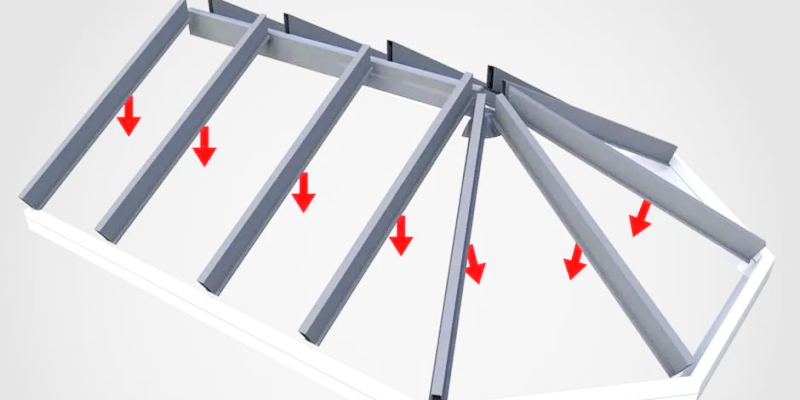
Why Choose FRP Pipe Experts for Industrial Pipe Repairs
How to Repair GRP Conservatory Roof
How to Repair a GRP Conservatory Roof
A GRP (Glass Reinforced Plastic) conservatory roof is highly durable and resistant to most wear and tear. However, damage such as cracks, leaks, or surface abrasions may occasionally occur due to heavy impact, improper installation, or age. Fortunately, repairing a GRP conservatory roof is relatively straightforward and can often be done without professional assistance. Below is a step-by-step guide to repairing your GRP conservatory roof.
Identify the Damage
Before starting the repair, inspect the roof carefully to locate the damage. Common issues include:
- Cracks or splits: Visible lines where the material has broken.
- Leaks: Water ingress, often around edges or joins.
- Abrasion or wear: Surface damage caused by environmental factors.
Gather Necessary Materials
To repair your GRP roof, you’ll need the following tools and materials:
- GRP repair kit (includes resin, topcoat, catalyst, and fiberglass matting)
- Sandpaper (coarse and fine grit)
- Acetone or cleaning solvent
- Paintbrushes or rollers
- Protective gloves and goggles
- Utility knife or scissors (for cutting fiberglass matting)
- Masking tape (optional)
Prepare the Damaged Area
Proper preparation is crucial for a successful repair:
- Clean the area: Remove dirt, grease, or loose particles using acetone or a similar cleaning solvent.
- Sand the surface: Use coarse sandpaper to roughen the damaged area and surrounding edges. This ensures the new resin adheres properly.
- Cut fiberglass matting: Cut a piece of fiberglass matting slightly larger than the damaged area. Prepare multiple layers if the damage is severe.
Apply the Resin and Fiberglass Matting
Once the area is prepped:
- Mix the resin: Combine the GRP resin with the catalyst as per the manufacturer’s instructions. Mix thoroughly to activate the resin.
- Apply a base layer of resin: Use a paintbrush or roller to spread a thin layer of resin over the damaged area.
- Lay the fiberglass matting: Place the pre-cut matting onto the resin while it’s still wet. Press it firmly to ensure full contact.
- Apply more resin: Coat the fiberglass matting with additional resin until it is fully saturated. Use the brush to remove air bubbles and smooth out the surface.
Allow to Cure
- Let the resin cure for the time specified in the repair kit instructions. This usually takes 2–6 hours, depending on the weather and resin type.
- Avoid disturbing the repaired area while it cures.
Sand and Apply the Topcoat
After the resin has cured:
- Sand the surface: Smooth the repaired area with fine-grit sandpaper to blend it with the surrounding roof.
- Clean the area: Wipe away dust with a cloth and acetone.
- Apply topcoat: Mix and apply the GRP topcoat (including the catalyst) over the repaired area. This provides a waterproof and UV-resistant finish.
Inspect the Repair
- Once the topcoat has dried (typically within 24 hours), inspect the area to ensure it is sealed and smooth.
- If necessary, apply additional topcoat layers for added durability.
Prevent Future Issues
- Regularly inspect the roof for early signs of wear or damage.
- Ensure gutters and drainage are clear to prevent water buildup.
- Avoid heavy impacts, such as dropping tools or sharp objects on the roof.
When to Call a Professional
While many GRP roof repairs can be done by homeowners, you may need professional help if:
- The damage is extensive or structural.
- Leaks persist after multiple repair attempts.
- You are unsure about safety or the correct repair process.
Repairing a GRP conservatory roof is a manageable DIY task if the damage is minor. By following these steps and using the right materials, you can restore your roof’s integrity and extend its lifespan. However, for significant damage or complex repairs, consulting a professional ensures the problem is addressed effectively.
Choosing the Right GRP Conservatory Roof Solution
How to Select the Best GRP Roofing Company
Selecting the right company to install your grp conservatory roof is a crucial step in ensuring a successful project. Begin by researching companies with a solid reputation in GRP roofing installation. Look for businesses that specialize in GRP roofs rather than general roofing contractors, as this specific expertise will ensure that the job is done correctly. Reading online reviews and customer testimonials can provide valuable insights into the quality of work a company delivers, helping you gauge their reliability and professionalism.
Another important factor is certification and accreditation. A reputable GRP roofing company should have the necessary qualifications, such as certification from recognized industry bodies. These credentials demonstrate that the company follows best practices and maintains high standards in their installations. Additionally, ask for a portfolio of their previous work, especially projects involving grp conservatory roof installations, to assess their experience and craftsmanship. This will give you a clearer understanding of their ability to handle the unique challenges of conservatory roofing.
When requesting quotes, don’t just focus on the price. While affordability is important, be sure to consider the quality of materials used, the scope of services offered, and the warranties provided. A lower quote might save you money initially, but poor workmanship or substandard materials could result in costly repairs down the line. Choose a company that offers a comprehensive warranty on both the installation and the materials used, giving you peace of mind for years to come.
Importance of Professional Installation to Maximize Roof Longevity
Professional installation of your grp conservatory roof is essential for maximizing its lifespan and performance. Even the best materials can fail if they are not installed correctly. A skilled roofing professional ensures that each step of the installation process is performed with precision, from preparing the existing structure to applying the GRP panels and resin. Proper installation not only ensures the roof’s structural integrity but also prevents common issues like leaks, poor insulation, or premature wear.
A professionally installed grp conservatory roof will be seamless and watertight, eliminating the risk of water ingress and the damage that comes with it. This is especially important for conservatories, where maintaining a comfortable indoor environment is key to enjoying the space year-round. A roof that isn’t installed correctly may lead to poor insulation, resulting in higher energy bills and inconsistent temperatures inside the conservatory.
Moreover, professional installers can tailor the GRP roof to your conservatory’s specific design, ensuring a perfect fit around any architectural features. They can also incorporate additional elements such as skylights or roof windows without compromising the roof’s waterproofing or energy efficiency. The precision and expertise offered by a professional installer make a significant difference in both the immediate results and the long-term performance of the roof.
Why a GRP Conservatory Roof is the Ideal Choice
A grp conservatory roof offers homeowners a variety of benefits that make it a superior option for upgrading their conservatory. Its durability ensures that it will last for decades, requiring minimal maintenance due to its seamless, weatherproof design. The insulation provided by a grp conservatory roof helps regulate temperature, making your conservatory comfortable to use throughout the year while reducing energy costs. In addition to these practical benefits, GRP roofs are highly customizable, allowing you to enhance the aesthetics of your conservatory and ensure it complements the overall style of your home.
If you’re ready to improve your conservatory with a high-performance, visually appealing roof, consider exploring the available grp conservatory roof options. For more information on GRP roofing solutions and to get personalized pricing details, contact us for a no-obligation consultation today. Our experts are here to help you choose the perfect roof for your conservatory, ensuring you get the best solution for your home’s needs.
FAQs about GRP Conservatory Roof
While GRP roofing offers many benefits, there are some potential drawbacks to consider. One disadvantage is that GRP roofs can be more expensive upfront compared to traditional felt or rubber roofing options. Additionally, improper installation may lead to problems such as leaks or insufficient insulation. It’s important to ensure that the roof is installed by a professional with experience in GRP materials. In colder climates, GRP roofs may become slippery when wet, posing a potential safety hazard. Regular inspections are also needed to ensure the resin and top coat remain in good condition over time.
Yes, a fiberglass roof, or GRP roof, can be installed on a conservatory. In fact, GRP roofing is a popular choice for conservatories due to its durability and seamless finish. The watertight nature of GRP makes it an excellent option for preventing leaks and water damage. Additionally, GRP roofs offer superior insulation, helping to regulate temperatures within the conservatory throughout the year. This means that a conservatory with a GRP roof is more comfortable in both summer and winter, providing energy efficiency as well. GRP roofs can also be customized in various colors and finishes, allowing them to complement the design of your home.
GRP roofing, or Glass Reinforced Plastic roofing, is a lightweight, durable, and waterproof roofing system. It is made from a mixture of polyester resin reinforced with glass fibers, creating a strong and seamless surface. GRP roofs are commonly used for flat roofs, including conservatories, garages, and extensions, due to their superior water resistance and ability to withstand harsh weather conditions. This roofing system is highly customizable, offering various finishes and colors to suit different architectural designs. A GRP roof provides excellent insulation, helping to reduce energy costs and keep indoor spaces comfortable.
The life expectancy of a GRP roof is typically 25 to 30 years when properly installed and maintained. GRP roofs are known for their long-term durability and resistance to weather-related damage. Unlike felt or rubber roofs, which may require regular maintenance and repairs, GRP roofs are seamless, meaning there are no joints or seams where leaks can occur. With minimal maintenance, such as periodic cleaning and inspection, a GRP roof can last several decades without needing major repairs or replacement. Investing in a GRP roof is a long-term solution that offers both reliability and cost efficiency over its lifespan.
Both GRP (Glass Reinforced Plastic) and EPDM (Ethylene Propylene Diene Monomer) have their strengths. GRP is highly durable, long-lasting, and visually appealing, making it ideal for flat roofs and intricate designs. EPDM, on the other hand, is more cost-effective, quicker to install, and excellent for larger roofs due to its seamless application. GRP offers better resistance to impacts and weathering, while EPDM is known for its flexibility and ability to withstand extreme temperatures. The choice depends on the specific requirements of your project, such as budget, design, and durability needs.
GRP roofs may crack due to several factors:
Poor installation, such as inadequate resin curing or insufficient layers.
Structural movement of the underlying building, causing stress on the rigid material.
Temperature fluctuations, which can lead to expansion and contraction stresses.
Damage from heavy impacts or foot traffic.
To prevent cracks, ensure the roof is installed by professionals and that proper preparation and materials are used. Regular maintenance and inspections can also help identify and address minor issues before they worsen.
Yes, installing a proper roof on a conservatory can be highly beneficial. It improves insulation, making the space usable year-round by regulating temperatures more effectively. A proper roof can also reduce noise from rain and external sources, enhancing comfort. Additionally, it adds aesthetic value and may increase the property’s resale value. While the initial cost might be higher than maintaining a traditional polycarbonate or glass roof, the long-term energy savings and increased functionality make it a worthwhile investment for many homeowners.
Yes, it is generally safe to walk on a fibreglass (GRP) roof, but precautions should be taken. GRP roofs are strong and durable when properly installed, but overloading or sharp impacts can cause damage. Avoid walking on the roof in extreme temperatures, as the material may become more brittle in cold weather or soften in high heat. Use soft-soled shoes to prevent scratching or puncturing the surface. If frequent access is needed, consider installing walkways or reinforcing the structure to ensure safety and longevity.
In most cases, GRP roofs do not require expansion joints due to their seamless and rigid design. The material’s natural properties allow it to expand and contract slightly without compromising integrity. However, for larger roofs or those exposed to significant temperature fluctuations, it may be advisable to include expansion joints to minimize the risk of stress fractures or cracking. Consult with a roofing professional to determine the best approach for your specific project and ensure proper installation techniques are followed.
GRP roofs are generally not considered noisy. Unlike metal roofs, which can amplify the sound of rain, GRP roofs offer a solid, seamless surface that minimizes noise transmission. However, in heavy rain or hail, some sound may still be audible, but it is typically less intrusive than on other roofing materials. Proper insulation beneath the GRP roof can further reduce any noise. If soundproofing is a key concern, combining the GRP roof with acoustic insulation materials is a practical solution.

As the editor of GangLong Fiberglass, I have years of experience and in-depth research, focusing on cable tray products, fiberglass solutions, and grille systems. I incorporate years of industry insights and practical experience into every content, committed to promoting the progress of the industry. At GangLong Fiberglass, my commitment is reflected in every product, from innovative cable trays to durable fiberglass solutions and sturdy grille systems. As an authoritative voice in the industry, my goal is to provide valuable information to professionals and businesses and promote forward-looking solutions.

